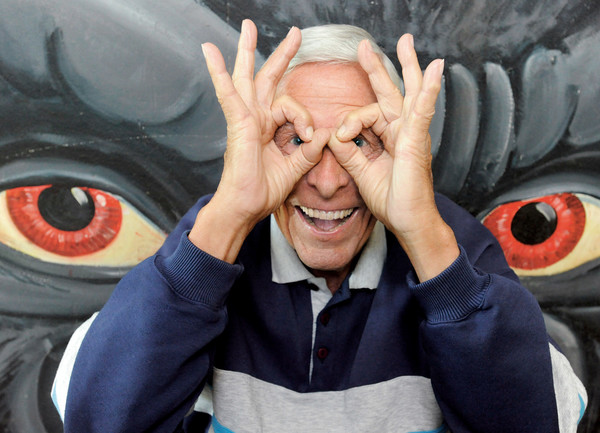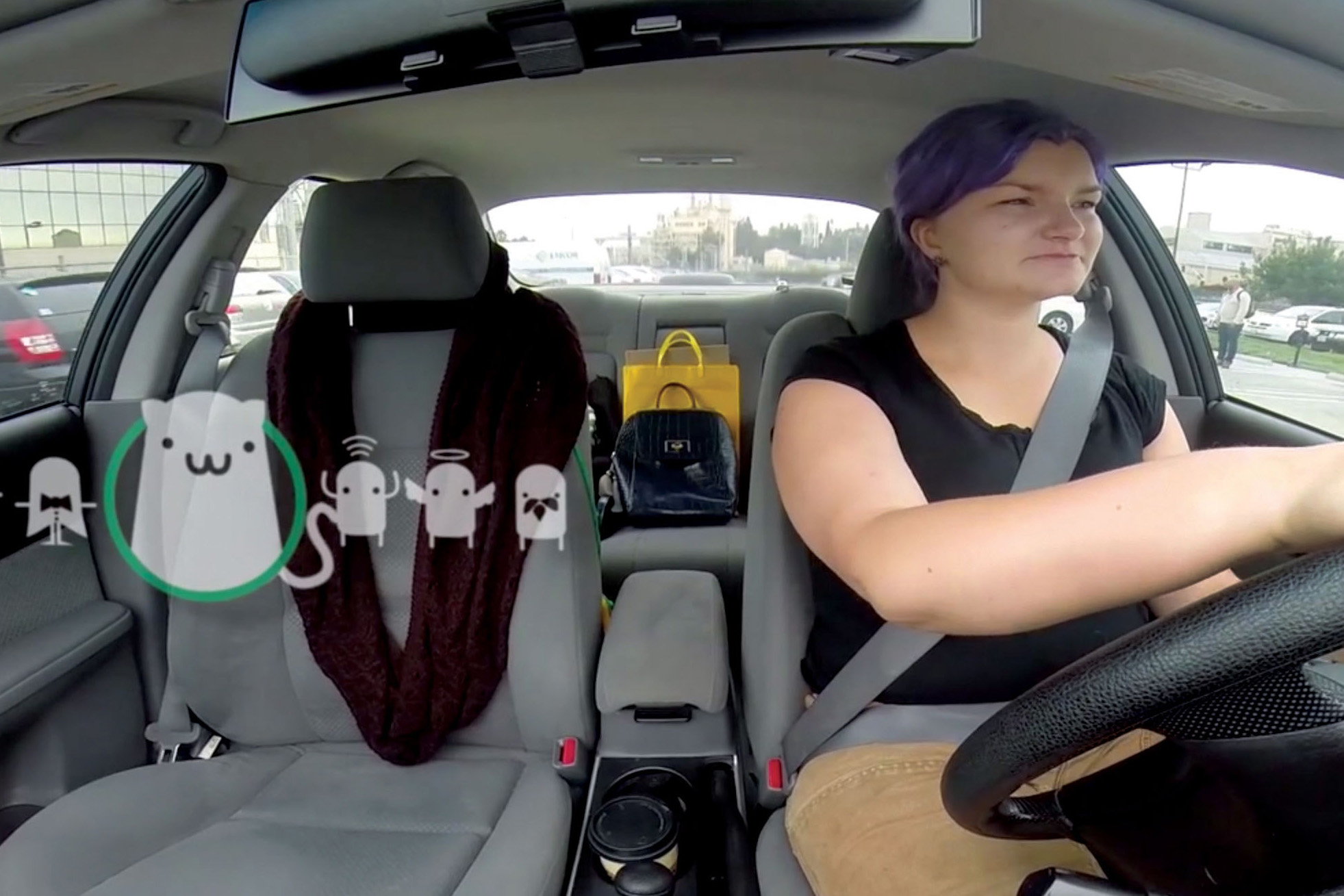
Photo (above and upper right below): Stella Kalinina
feature / alumni / faculty / students / art / graphic-design / illustration /
October 12, 2016
Writer: Mike Winder
Sculpting Reality: Fine art student Filip Kostic deploys VR to ask big questions and create new meanings
Artists’ tools have evolved throughout history, perpetually expanding the possibilities for expression. And whether it’s Michelangelo’s frescoes on the ceiling of the Sistine Chapel or James Turrell’s Breathing Light, a longstanding goal of art has been to create immersive realities.
At ArtCenter, Fine Art student Filip Kostic stands out. Not just because he’s six-feet-nine-inches tall, but because he’s using his medium of choice—virtual reality (VR)—to engage his audience both emotionally and critically.
This past April, during the last week of the Graphic Design course Mediatecture, Kostic unleashed his latest experiment on a group gathered in the basement level of the 950 Building at ArtCenter’s South Campus. It was there that Kostic instructed a brave volunteer to sit down at his custom-made, high-end desktop computer and to put on the connected Oculus Rift. What happened next is not easy to describe.
With the VR headset over her eyes, the student found herself in a perfect 1:1 recreation of her surroundings. What she saw in that digital space mirrored exactly what she would have seen with the headset off, sans all the observers. After 30 seconds had elapsed, she found herself transported to an office space.
Then reality fell apart.
The room dissolved; individual elements broke away and floated through the space. A large rock emerged from the floor, emitting ominous music, and began orbiting her. A few seconds later, the student looked down at her body and discovered that she herself had transformed into the rock.
And just like that, the experience was over.
“People were freaked out at first,” Kostic says later in his studio at South Campus’ 870 Building. “But when they realized what was happening, they really started paying attention.” To create the work, he had mapped the tall, angular basement’s spatial dimensions and recreated the room virtually using the Unreal Engine game development software.
The project brings to mind everything from Plato’s “Allegory of the Cave” to Michel Gondry’s Eternal Sunshine of the Spotless Mind, and we could easily write a thesis dissecting the experience. But for now, let’s just ask the most obvious question: What’s the deal with the rock?
“I’ve thought a lot about rocks and their contextual value in human history,” says Kostic, pointing to his earlier what do rocks think about?, a 1:1 VR-driven installation that revolved around a physical computer encased within a faux rock. “First the rock was a tool, then it became foundation, and then it became material.”
Kostic’s deep dive into VR is remarkable considering he hadn’t worked with the technology prior to the Mediatecture course. It was in that classroom that instructor Ivan Cruz (BFA 11 Graphic Design) loaned Kostic his Oculus Rift.
“Filip had 3D and programming comprehension, which enabled him to quickly learn the Unreal Engine,” says Cruz, who in addition to teaching at ArtCenter also freelances at several production studios and agencies, including B-Reel, Ueberall International and Mirada. “I handed him the Oculus and asked him, ‘How do you tell a story with this?’”
It was a challenge he was well prepared for, says Fine Art faculty Jean Rasenberger (MFA 92 Art), who has witnessed the development of Kostic’s exploration of the technological limits of art over the past few years. She points to his seven seas triple rabbit—a large cactus on wheels which doubles as a phone charger—and these spaces are real too—an installation in which Kostic himself, projected onto a cutout silhouette, narrates simultaneous video tours of Beograd, Serbia and Torrance, California — as examples of earlier works that anticipated the territory he’s currently exploring.
“Filip has an intellectual curiosity and he’s deeply engaged in the discourse we’re having today,” says Rasenberger, who teaches Structures and Systems and Film and Video, among other courses. “He didn’t come from an art background, but when he entered our department something ignited within him and now he’s unstoppable.”
“I’ve always been interested in how technology can accompany art to create more meaning,” Kostic explains, reflecting on his ArtCenter arc that began with drawing, moved on to painting, then shifted to sculpture, video and transforming functional objects (like the Roomba vacuum cleaner) into artworks. “That was the ladder I was ascending, but then I somehow fell down the steps and landed in virtual reality.”
More like hit the ground running. During the Summer 2016 term, he created a senior project titled me, from the future!, a 1:1 VR installation that featured a physical nine-foot-tall obelisk that referenced the plank sculptures of John McCracken, and its virtual counterpart, a glowing rectangular portal (Go ahead, stick your head inside.). He also played a key role in a group project called Viya in the transdisciplinary studio Driving Sensations, in which users sit in an abstracted car mold, select a physical stylized instrument panel from a classic car of their choice, and then take that vehicle for a virtual joyride; co-headed the ArtCenter VR Club, a student group he founded with Film student Nathan Strong; and developed the Fall 2016 course Virtual Reality: A New Lens, which will be co-taught by faculty Ming Tai, Eric Parren and Ashley Pinnick (BFA 15 Illustration), for which Kostic will serve as a teaching assistant.
Where will Kostic take VR next? “I want to continue to incorporate it into my practice and explore what it means to make objects when virtual objects exist,” he says, and adds that he also plans on creating immersive video games after he graduates this Fall term. “But I want to be very mindful of its implications.”
When it comes to creating meaningful work, that type of criticality is key, says Mitchell Kane, director of the Fine Art department. “Right now there’s a wow and gee-whiz factor to VR, but it’s necessary to go a step beyond,” says Kane, who taught Kostic in his New Media Arts course titled “Post-Experiential.” “Filip understands it’s not just about the thrill of the new and that there needs to be ideas behind the experience.”
And with everybody racing to monetize VR, Kostic says the time for asking the bigger questions is now. Like many individuals working with VR, he points out that it’s a young medium rife with unknowns. He adds, “We’re all grabbing at land masses in a space that doesn’t exist yet.”












